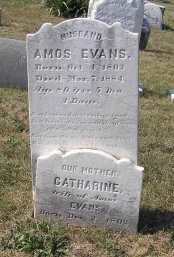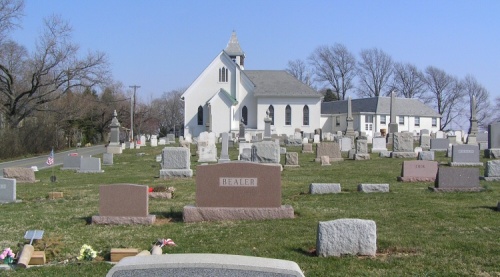 The theme this week is Valentine, and I chose to write about Catherine Keeley Evans because she is my ancestor with the longest marriage. On December 26, 1822 Catherine Keeley married Amos Evans.1 She was 20 and he was 19. The marriage ended on March 7, 1884, upon the death of Amos.2 They were married an incredible 61 years, 2 months and 10 days!
The theme this week is Valentine, and I chose to write about Catherine Keeley Evans because she is my ancestor with the longest marriage. On December 26, 1822 Catherine Keeley married Amos Evans.1 She was 20 and he was 19. The marriage ended on March 7, 1884, upon the death of Amos.2 They were married an incredible 61 years, 2 months and 10 days!
Here’s a little more information about Catherine. She was born on December 15, 1802 to Jacob Keeley and Mary Shimer.3 [Note: I have written about her mother Mary Shimer Keeley earlier this year. That blog post can be found here.] Catherine was the youngest of their nine known children. It was a family of six girls and three boys. They were Hannah, Sebastian, Elizabeth, Jacob, George, Mary, Esther, Sarah and Catherine.
Catherine likely spent the first several years of her life in Limerick township, Montgomery County, PA where her family was enumerated in the 1800 census.4 Upon the death of her paternal grandmother Elizabeth Frey Keeley in 1808, her parents purchased the family homestead. It was located across the Schuylkill River in East Vincent Township, Chester County, PA, near Sheeder’s Mill.5 Life would have been a little different for the family as they now ran an inn and owned a grist mill.6 Unfortunately, this life would not last long. In April of 1814, Jacob and Mary both died within one day of each other. Jacob died of typhoid fever and it is probable that Mary did as well.7,8
Catherine was 11 years old when she was orphaned. Her sisters Sarah and Esther were also minors, aged 13 and 16 respectively. The other siblings were grown and most were married. We do not know for sure what happened to Catherine, Sarah and Esther after the death of their parents. The court appointed Capt. John Adam Miller as Catherine’s fiduciary guardian. Sarah and Esther, being over age 14 by the time of probate chose their own. Sarah chose John Hause and Esther chose John Titlow.9 These guardians were responsible for managing the girls’ inheritance until they came of age. so it is quite possible that they actually lived with one of their older siblings.
As noted before, Catherine married Amos Evans in 1822 when she was 20 years old. Amos was from the Evans family whose ancestors settled in Limerick Township, (then Philadelphia, now Montgomery County), Pennsylvania in the early 1700s. After their marriage, Catherine and Amos lived in Limerick Township on the Evan’s land, where Amos followed the occupation of farmer.10, 11, 12, 13 The couple raised a large family of 12 children. They were Edward, Mary Ann, Elizabeth, Catherine, Amos K., William, Daniel, Matilda Ann, Sarah Ann, John P., Harriet and Lewis. Thanks to a cousin marriage a couple of generations later, I actually descend from two of these children. Mary Ann was my 3x great-grandmother and John P. was my 2x great-grandfather.
Amos and Catherine suffered their share of trials and tribulations during their marriage. Of their twelve children, only six were still living when Amos died.14 My ancestor, Mary Ann, was one of those who pre-deceased her parents. She died in 1862 at the age of 37.15 I have not uncovered her cause of death. My other ancestor, John, was one of the surviving children. He died in 1906 at the age of 66.16 Another child that died early was Daniel. His story was particularly tragic in that he drowned in 1866 at the age of 32 when he accidentally fell from his canal boat while passing through a lock. He left a wife and two young children.17
In their later years Amos and Catherine moved from their farm in Limerick Township to a house in the borough of Pottstown. Amos was still working at the age of 77 and was employed at the roller mills.18 He died four years later (March 7, 1884) at the age of 81.19 After Amos’ death Catherine continued to be an active part of the lives of her children and grandchildren. In October of 1884, Grandmother Evans (as she was known) attended the surprise 64th birthday party of her former son-in-law, George K. Miller.20 (George had been the husband of my ancestor Mary Ann Evans who died in 1862.)
 Catherine died on January 16, 1886 at the age of 83. She was survived by 5 of her 12 children. (Daughter Sarah Ann, wife of Augustus Scheffey, had died the year before.21) She was also survived by 32 grandchildren and 42 great-grandchildren!22 She was buried along side her husband at the churchyard in Limerick Township. It seems appropriate that when I was there to photograph tombstones in 2005 Catherine’s broken stone was propped against that of her husband Amos.23
Catherine died on January 16, 1886 at the age of 83. She was survived by 5 of her 12 children. (Daughter Sarah Ann, wife of Augustus Scheffey, had died the year before.21) She was also survived by 32 grandchildren and 42 great-grandchildren!22 She was buried along side her husband at the churchyard in Limerick Township. It seems appropriate that when I was there to photograph tombstones in 2005 Catherine’s broken stone was propped against that of her husband Amos.23
Sources/Footnotes
- GenealogyBank, “Historical Newspaper Archive, 1690-2010,” database, Genealogy Bank (genealogybank.com: accessed ), Marriage of Amos Evans and Catharina Keely, citing records of Reading Adler, 7 January 1823.
- Pennsylvania. Pottstown., Montgomery Ledger, “Obituary of Amos Evans,” March 11, 1884.
- Falkner Swamp Reformed Church (New Hanover Township, Montgomery, Pennsylvania), “Records of Falkner Swamp Reformed Church,”, birth/baptism of Catharine Keely.
- 1800 U. S. Federal Census population schedules (National Archives and Records Administration), Series: M32 Roll: 41 Page: 761. Household of Jacob Keely
- Chester County Archives and Records, “Deed Book Index, 1681-1820,” database, Jacob Keely purchased land in Vincent Township, 1808.
- Ancestry.com. Pennsylvania, Wills and Probate Records, 1683-1993 [database on-line]. Provo, UT, USA: Ancestry.com Operations, Inc., 2015. Will of Sebastian Keeley – includes description of real property
- Zion Lutheran Church (East Pikeland Township, Chester, Pennsylvania), “Records of Zion Lutheran Church.” death record for Jacob Keely.
- Tombstone Photographs – digital images (privately held by Janis Tomko), Brownback’s UCC Cemetery, photographed 6/25/2005. Tombstone for Mary Shimer Keeley
- Orphan’s Court File – Decedent Jacob Keely Vincent township, 1814, Chester County Archives and Records, West Chester, Pennsylvania. Guardianship petitions for Catherine, Sarah and Esther.
- 1830 U.S. census, Ancestry.com, Digital images (National Archives and Records Administration, n.d.), Census Place: Limerick, Montgomery, Pennsylvania; Series: M19; Roll: 154; Page: 262. Household of Amos Evans.
- 1840 U.S. census, Ancestry.com, Digital images (National Archives and Records Administration, n.d.), Census Place: Limerick, Montgomery, Pennsylvania; Roll: 478; Page: 166. Household of Amos Evans.
- 1850 U.S. census, Ancestry.com, Digital images (National Archives and Records Administration, n.d.), Census Place: Limerick, Montgomery, Pennsylvania; Roll: M432_799; Page: 81B; Image: 163. Household of Amos Evans
- 1860 U.S. census, Ancestry.com, Digital images (National Archives and Records Administration, n.d.), Census Place: Limerick, Montgomery, Pennsylvania; Roll: M653_1145; Page: 150. Household of Amous[sic] Evans.
- “Obituary of Amos Evans”
- Pennsylvania. Pottstown., Montgomery Ledger, “Death Notice of Mary Ann Miller,” 20 Jan 1863.
- Ancestry.com. Pennsylvania, Death Certificates, 1906-1966 [database on-line]. Provo, UT, USA: Ancestry.com Operations, Inc., 2014. death cert of John P. Evans
- Pennsylvania. Pottstown., Montgomery Ledger, “Drowning Case,” November 20, 1866.
- 1880 U.S. census, Ancestry.com, Digital images (National Archives and Records Administration, n.d.), T9, roll 1158, Lower Pottsgrove, Montgomery County, Pennsylvania, enumeration district (ED) 24, p. 13. Household of Amos Evans
- “Obituary of Amos Evans”
- Pennsylvania. Pottstown., Montgomery Ledger, October 17, 1884. Birthday celebration for George K. Miller.
- Pennsylvania. Pottstown., Montgomery Ledger, “Obituary of Sallie Scheffey,” May 12, 1885.
- Pennsylvania. Pottstown., Montgomery Ledger, “Obituary of Catherine Evans,” January 19, 1886.
- Tombstone Photographs – digital images (privately held by Janis Tomko), Limerick Church Burial Ground, Limerick, Montgomery, Pennsylvania, photographed October 2, 2005.







